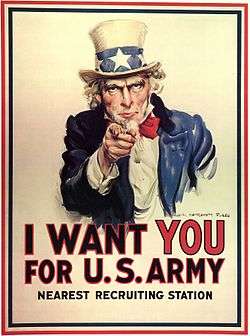Slogans of the United States Army

Slogans of the United States Army changed rarely in the 20th century, relative to the 21st.
2006 to 2016
"Army Strong" was the recruiting slogan that was used for nearly a decade by the United States Army. The composer of the music used in the Army Strong television commercials is Mark Isham.[3]
2001 to 2006
"Army of One" was a relatively short-lived recruiting slogan. It replaced the popular "Be All You Can Be" and was replaced in 2006 by the new slogan "Army Strong".[4] The reason for the replacement, states Frank Luntz, is that the slogan "Army of One" is contrary to the idea of teamwork.[5] It is unknown whether this slogan was taken directly from the poster for the 1976 Clint Eastwood film The Outlaw Josey Wales, which had "An Army of One" under a drawing of the Josey Wales character.
1980 to 2001
"Be All You Can Be" was the recruiting slogan of the United States Army for over twenty years.[6] Earl Carter (pen-name, E.N.J. Carter) working for the N.W. Ayer Advertising Agency as a Senior Copywriter created the “Be All You Can Be” theme line in 1980.[7] In January 2003, the U.S. Army awarded Carter its Outstanding Civilian Service Award.[8] Carter’s original concept sheet, with words “Be All You Can Be”, is now part of a permanent collection at the US Army Heritage Center Foundation.
1971 to 1980
"Today's Army Wants to Join You" was a recruiting slogan from the 1971 Volunteer Army (Project VOLAR) campaign, which was introduced as the country prepared to transition to an all-volunteer military. When N. W. Ayer & Son, who were engaged by the US Army, believed they felt the army said "Today's Army is changing; we want to meet you half way", the firm came up with that slogan. General William Westmoreland asked "Do we have to ask it that way?" but agreed to the campaign. The slogan was replaced by "Join the People Who've Joined the Army" in 1973, which later evolved into "This is the Army."[9]
Slogan was written in 1971 by Ted Regan Jr., Executive Vice President and Executive Creative Director of N.W. Ayer, the Army's ad agency. Regan also wrote the follow up slogan, "Join the people who've joined the Army."
1950s–1971
"Look Sharp, Be Sharp, Go Army!" was a recruiting slogan in the 1950s and 1960s. The Big Picture, public announcements on broadcast television, and highway roadway signs advertised the slogan during a time of a national draft of young men 18 to 34 years of age. The advantage of volunteering for service as opposed to being drafted was the option to choose which career field you wanted to serve in along with the first unit and/or location of assignment.
World War I
"I Want YOU for US Army" featured on a poster of Uncle Sam painted by James Montgomery Flagg.
See also
References
- ↑ "The Most Famous Poster". American Treasures of the Library of Congress.
- ↑ "Who Created Uncle Sam?". Life's Little Mysteries. Live Science. Archived from the original on 3 December 2008. Retrieved 16 February 2012.
- ↑ The making of "Army Strong"
- ↑ Tyson, Anne Scott (22 November 2006). "Army Debuts New Slogan in Recruiting Commercials". The Washington Post. Retrieved 2012-06-12.
- ↑ Luntz, Frank. Words That Work. p. 119. ISBN 9781401385750.
Why did the U.S. Army jettison "be all that you can be," surely one of the most widely known taglines in the world, for the rather odd and uninspiring "An army of one"? Especially when an "army," by definition, is more than one person. While it is understandable for an organization like the military to want to individualize and personalize what it does, that's just not a believable or credible selling point.
- ↑ AdSlogans.com - Wise Words/13 Archived 19 December 2010 at WebCite
- ↑ “America’s Army”, Beth Bailey, Pages 191, 192
- ↑ http://earlcarterawards.com/armypressrelease.pdf Archived 19 December 2010 at WebCite
- ↑ pp.141–142 Griffith, Robert K. & Wyndham, John U.S Army's Transition to the All Volunteer Force 1868–1974 1997 DIANE Publishing